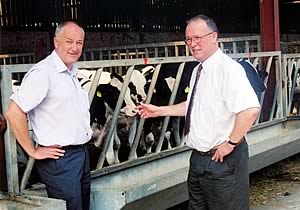| 03/10/06
A £96/head increase in gross margin was the key financial
benefit from feeding a quality high starch concentrate to intensively
reared beef cattle in a recent trial conducted at Harper Adams University
College for Wynnstay.
Steve Brown (left) with Simon Marsh
 |
In the eight-month study that monitored the performance of 30 bulls
from around 195kg through to slaughter, animals receiving a 33% starch
proprietary beef nut recorded a £126/head gross margin compared
with £30/head by the control group that was fed a typical “low
cost” concentrate. The improved financial return was due to
significantly higher growth rates and carcass weights, and improvements
in feed conversion efficiency.
The low starch beef nut (8% starch) would mirror many of the ‘low
cost’ diets currently being fed in intensive rearing situations,
according to Harper Adams’ beef specialist Simon Marsh, and
was formulated to offer comparable crude protein and energy levels
to Wynnstay’s Prime Beef nut.
“Very little recent research is available on the optimum starch
content for intensively reared beef cattle,” he says, “so
this project is significant in offering some much-needed guidelines.
“We compared two diets of identical energy and protein status
under trial conditions, with only the starch content varying. Using
standard costs at the time of the trial, the low starch ration was
about 5% cheaper than the high starch ration, but the difference
in performance was quite remarkable.
“Cattle on the high starch nut actually exceeded the targets
that we would set for this type of system, assuming optimum conditions
and management.”
Holstein bulls housed in straw yards came into the trial at around
5 months of age, averaging just under 195kg liveweight, and received
their respective concentrate rations ad lib along with straw.
No health problems were recorded in either group during the trial
period, and cattle were selected for slaughter at fat class 3.
The high starch group reached slaughter weight 12 days earlier on
average and with over 22kg additional carcass weight. Though not
statistically significant, there was also an improvement in killing
out percentage and in the carcass classification of the cattle receiving
the high starch ration, which contributed to a higher price per kilogram.
According to Steve Brown, ruminant technical manager for Wynnstay’s
feeds division, the trial illustrates key technical details that
need to be taken account of if beef producers are to be profitable
in the future.
“Whether you are producing beef for premium branded markets,
or more of a commodity product, technical details will make the difference
between profit and loss,” he stresses.
“This work shows that a lower cost ration is unlikely to result
in a higher margin, because it is performance – and not just
price/tonne – that dictates profit.
“Intensive beef is most likely to be about throughput, so reducing
the time to slaughter and increasing the value of the finished animal
is of paramount importance.”
 Supermarket led beef price squeeze will end if finishers toughen up selling Supermarket led beef price squeeze will end if finishers toughen up selling
 Seriously short farm assurance cover on Republic of Ireland beef Seriously short farm assurance cover on Republic of Ireland beef
 European
Focus On Beef And Lamb European
Focus On Beef And Lamb |


